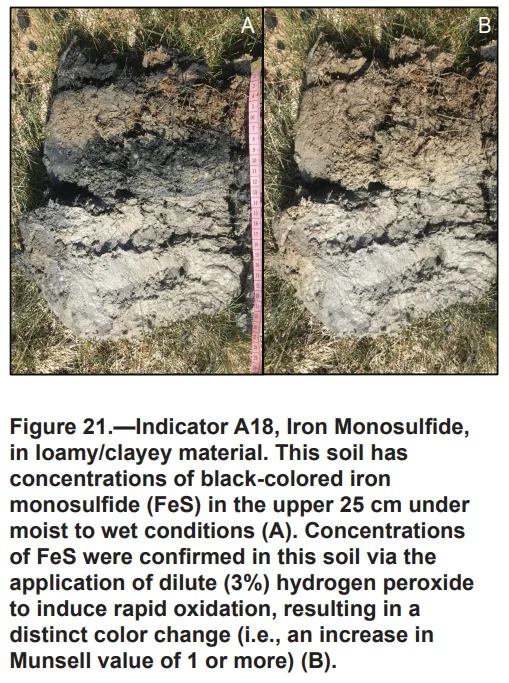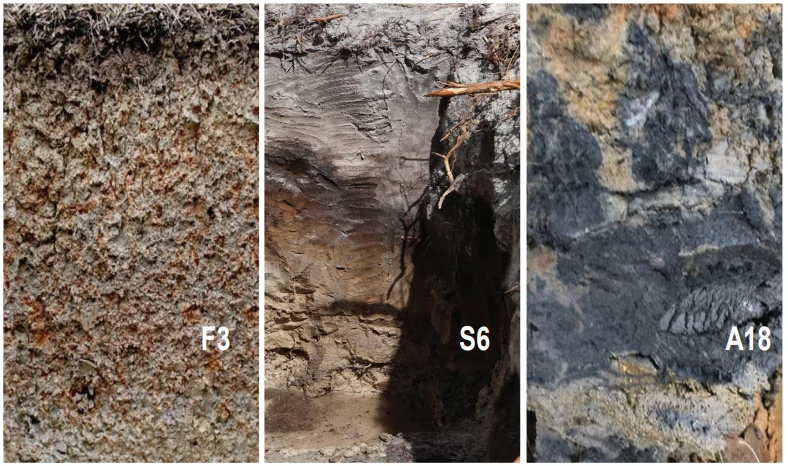In late 2024, the USDA-NRCS released Field Indicators of Hydric Soils in the United States version 9.0. Here’s what changed.
Adapted and shared with permission from Mike Callahan, CPSS of Soil Hub. Learn more about the author below.
New Indicator: A18 – Iron Monosulfides
The biggest update in version 9.0 is the addition of a new indicator: A18 – Iron Monosulfides.
This indicator applies to all Land Resource Regions (LRRs), meaning it can be used anywhere, affecting anyone identifying hydric soils. Here’s the official indicator description:
“Positive identification of dark-gray or black iron monosulfide concentrations with a value of 4 or less and chroma of 2 or less, starting at a depth of 25 cm (10 inches) or less from the soil surface.”
What does this mean in the field? In practical terms, you’ll likely see black colors in freshly excavated soil that lighten with exposure to air. The key here is the relatively rapid change in color. Unlike organic matter, which can appear dark or black and do not oxidize rapidly, iron monosulfides oxidize quickly, shifting to lighter shades (i.e., increasing in value by at least one color chip).
Figure 21 from the Field Indicators book demonstrates this change. The left side (A) shows the soil upon excavation. The right side (B) shows the same soil after oxidation of the iron monosulfides. Notice how the black areas essentially go away in picture B.

To assist with identification, a flowchart in the glossary walks you through confirming FeS presence, shown below.

Here’s A18 contrasted against F3 and S6:

Other Notable Changes in Version 9.0
- The Test Indicators section has been removed. Some former test indicators have been incorporated into A, S, or F indicators, while others were discontinued or will be included in a forthcoming Problematic Soils document.
- Text clarifications across multiple indicators aim to improve usability for field practitioners.
Using the Most Up-to-Date Indicators
Keep in mind that the Version 9.0 updates have not yet been incorporated into the USACE Regional Supplements (as of this blog post). While the supplements reference the Field Indicators, they don’t always contain the latest language.
For the most current information, refer directly to the Field Indicators of Hydric Soils or use resources like Soil Hub’s Hydric Soil Indicator App or Ecobot Collector’s built-in soil suggestions for wetland delineations.
There’s no constant but change, and that certainly applies to the science of the hydric soil indicators.
Ecobot supports accurate soil identification in the field with automated suggestions tailored to each USACE region. Try it out for free.
Check out other popular soil resources: Munsell Soil Reference Guide, Understanding Gley Soil
About the Author
Mike Callahan is a Certified Professional Soil Scientist with more than two decades of experience. He is the founder of Soil Hub, an online and in-person training resource for professionals who work in soil science related disciplines like on-lot septic, stormwater, wetlands, engineering, and geology. Soil Hub offers unique courses, resources, and community. Learn more at www.soilhub.com and explore the Hydric Soil Indicators mobile app.

.webp)

